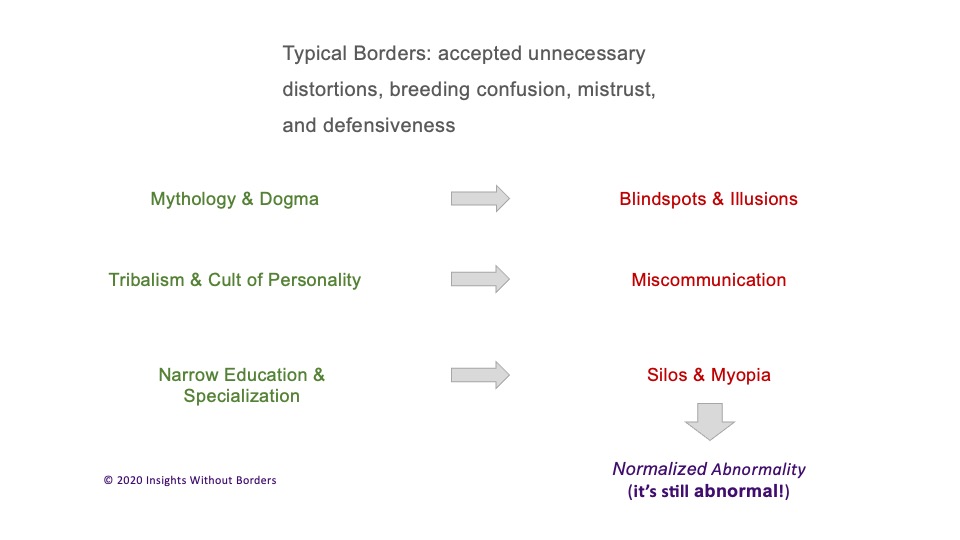“Wisdom lies neither in fixity nor in change, but in the dialectic between the two.” —Octavio Paz
Uncertainty is making it difficult for leaders and executives, employees, and workers to maintain their footing.
It is no longer if but when their world is becoming turned upside down or turned inside out.
Businesses or organizations with business as usual (BAU) approach will not last long.
Organizations often see what they want to believe, hear what they want to think, and then act in how they want to work—on what they are seeing, believing, hearing, and thinking.
Furthermore—innovatively misleading themselves into basically doing. Innovatively the same thing over-and-over-again.
Normalizing the abnormal (it’s still abnormal!)—assuring themselves, they are getting impending different innovative results or end-states.
You get what you settle for, right?
This mental modeling represents the surrounding world—categories, concepts, identities, prototypes, stereotypes, causal narratives, and worldviews.
It paints a picture of how these organizations sense the world—interpret their environment, and understand themselves. And the relationships between its various parts.
Furthermore, their thought process about how something works in the real world incorporates the taken-for-granted beliefs and routines of the climate and culture.
Which impact executives, employees, or workers’ understanding and perception about their actions and their consequences.
Mental modeling of organizations normalizing the abnormal (it’s still abnormal!) fears messy real-world complexities and relationships (human-centricity).
Because of their dilemma with pain points (adapt or die) or inflection points (pivot and thrive).
- How much honesty are they looking for?
- Or they want to hear?
- Can they handle the truth—around boardroom tables, leadership, line managers, or high-performance teams in your workplace?
Context
Any behavior is purposeful, claimed physician and psychiatrist Alfred Adler, if we understand the context.
We often find ways to familiarize maladaptive and malfunctional behaviors to our environment, even when they become detrimental to us and others.
A narrow street is only as wide, says Anthony T. Hicks, as the person that walks down it.
The same is likely about organizations—around boardroom tables, alignments with leadership teams, or high-performance teams.

This infographic is a visual representation of how the business or organizational wisdom lies neither in fixity nor change. Or sustained rigid mindsets and vested interests. But in the dialectic between the two: fixity and flux.
Power and Protective Behaviors
Process is, without doubt, Geary Rummler said, the most effective way to articulate value-added work to be done in an organization.
System flaws in businesses or organizations set up good people to fail.
“Put a good performer in a bad system,” Geary Rummler used to say, “the system will win every time.”
These symptoms often pathologize business or organizational climate and culture—normalization of deviance.
This chronic acceptance—cutting corners or making workarounds (“we’ll figure it out as we go along”) over time poses a significant danger to businesses or organizations’ wellbeing.
I have observed people in power in my clinical and business consulting work, often preventing transitioning and progress to safeguard their benefits.
Moreover, in my coaching practice with young leaders.
I observe that they fall in love with power and protective behavior that prevents fluid structures in either their business or organizational context once they are in this position.
Here, in both contexts, leadership becomes a prerogative for positions of power—and barriers at the top.
Such as low risk and conservative thinking. Limited intentional developmental orientation. A lack of letting go at the top. And a lack of persistence in the implementation of trends— ‘dipping in and out.’
Most successful leaders, who overcome skepticism, are those who diagnose the root of fundamental disagreements before trying to persuade. Say, Laura Huang, Harvard Business School professor, and Ryan Yu, an MBA candidate at Harvard Business School.
In her book, Edge: Turning Adversity into Advantage, Laura Huang says, these leaders first ask themselves— “What’s driving my detractor’s resistance?”
Leadership Competency
Says Michael R. Kutz, assistant professor of Athletic Training & Clinic Management in the School of Human Movement, Sport, and Leisure Studies at Bowling Green State University.
Intelligence in context, argued, Robert J. Sternberg, Professor of Human Development, Cornell University, relates to our environmental adaptation, selection, and shaping that characterize intelligent behavior in the everyday world.
This mode of intelligence, he tells us, involves purposive adaptation to, shaping of, and selection of real-world environments relative to one’s life.
Successful leadership teams, employees, or workers not only can adapt well to their environments; they also can modify the settings that they are in so they can maximize the fit between the environment and their adaptive skills.

